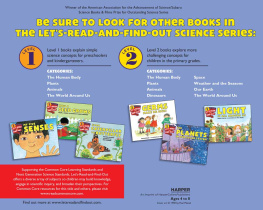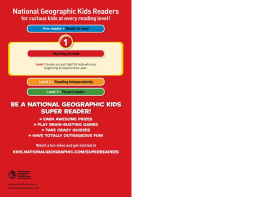Kathleen Zoehfeld - National Geographic Little Kids First Big Book of Science (Little Kids First Big Books)
Here you can read online Kathleen Zoehfeld - National Geographic Little Kids First Big Book of Science (Little Kids First Big Books) full text of the book (entire story) in english for free. Download pdf and epub, get meaning, cover and reviews about this ebook. year: 2019, publisher: Disney Book Group, genre: Children. Description of the work, (preface) as well as reviews are available. Best literature library LitArk.com created for fans of good reading and offers a wide selection of genres:
Romance novel
Science fiction
Adventure
Detective
Science
History
Home and family
Prose
Art
Politics
Computer
Non-fiction
Religion
Business
Children
Humor
Choose a favorite category and find really read worthwhile books. Enjoy immersion in the world of imagination, feel the emotions of the characters or learn something new for yourself, make an fascinating discovery.

- Book:National Geographic Little Kids First Big Book of Science (Little Kids First Big Books)
- Author:
- Publisher:Disney Book Group
- Genre:
- Year:2019
- Rating:5 / 5
- Favourites:Add to favourites
- Your mark:
- 100
- 1
- 2
- 3
- 4
- 5
National Geographic Little Kids First Big Book of Science (Little Kids First Big Books): summary, description and annotation
We offer to read an annotation, description, summary or preface (depends on what the author of the book "National Geographic Little Kids First Big Book of Science (Little Kids First Big Books)" wrote himself). If you haven't found the necessary information about the book — write in the comments, we will try to find it.
National Geographic Little Kids First Big Book of Science (Little Kids First Big Books) — read online for free the complete book (whole text) full work
Below is the text of the book, divided by pages. System saving the place of the last page read, allows you to conveniently read the book "National Geographic Little Kids First Big Book of Science (Little Kids First Big Books)" online for free, without having to search again every time where you left off. Put a bookmark, and you can go to the page where you finished reading at any time.
Font size:
Interval:
Bookmark:
NEIGHBORHOOD
NEIGHBORHOOD
science. The questions scientists ask are much like the questions children ask
every day. This book shows kids how scientists go about finding answers.
Activities sprinkled throughout encourage readers to keep a science journal and
begin some science experiments of their own. CHAPTER ONE provides an
introduction to science and the
scientific process. A simple example
shows kids that they already think
like scientists as they observe their
world, ask questions, come up with
hypotheses, and look for answers. CHAPTER TWO focuses on the
life sciences.
Readers see biologists,
botanists, and zoologists at work,
observing Earths amazing variety
of animals and plants. CHAPTER THREE explores
all aspects of planet Earthfrom
the rocks beneath our feet to the
clouds in the sky above. It shows astronomers learning about other
planets, oceanographers diving into
the sea, and geologists delving into
mysteries deep inside the Earth. CHAPTER FOUR is about the
material world that kids experience
all around them. Here they learn how
chemists mix substances to make new
substances and how physicists observe
the way things move.
illustrate science and scientists in
action on each spread.
illustrate science and scientists in
action on each spread.
POP-UP FACTS sprinkled
throughout provide additional
information about the main text. FACT BOXES help young readers
learn the names of the main branches
of science, the types of scientists who
work in those fields, and what aspects
of the world they study. Interactive QUESTIONS in each
chapter encourage conversation
related to the main topics. MORE FOR PARENTS in the back of the book offers parent tips that
include fun activities that encourage kids to think like scientists. Theres also
a helpful glossary.
science.
The questions scientists ask are much like the questions children ask
every day. This book shows kids how scientists go about finding answers.
Activities sprinkled throughout encourage readers to keep a science journal and
begin some science experiments of their own. CHAPTER ONE provides an
introduction to science and the
scientific process. A simple example
shows kids that they already think
like scientists as they observe their
world, ask questions, come up with
hypotheses, and look for answers. CHAPTER TWO focuses on the
life sciences. Readers see biologists,
botanists, and zoologists at work,
observing Earths amazing variety
of animals and plants.
CHAPTER THREE explores
all aspects of planet Earthfrom
the rocks beneath our feet to the
clouds in the sky above. It shows astronomers learning about other
planets, oceanographers diving into
the sea, and geologists delving into
mysteries deep inside the Earth. CHAPTER FOUR is about the
material world that kids experience
all around them. Here they learn how
chemists mix substances to make new
substances and how physicists observe
the way things move. CHAPTER FIVE takes a look at
how engineers use knowledge from all
branches of science to solve problems
and create useful inventions. Colorful PHOTOGRAPHS
illustrate science and scientists in
action on each spread.
POP-UP FACTS sprinkled
throughout provide additional
information about the main text. FACT BOXES help young readers
learn the names of the main branches
of science, the types of scientists who
work in those fields, and what aspects
of the world they study. Interactive QUESTIONS in each
chapter encourage conversation
related to the main topics. MORE FOR PARENTS in the back of the book offers parent tips that
include fun activities that encourage kids to think like scientists. Theres also
a helpful glossary. This chapter introduces you to the way scientists observe and
think about the world and how they go about finding answers.
Read on to find out how you can be a scientist, too.
world. This chapter introduces you to the way scientists observe and
think about the world and how they go about finding answers.
Read on to find out how you can be a scientist, too.
world.
If you wonder about the world and ask
a lot of questions, you are already thinking like a
scientist! Some questions are easy to answer. Others
are hard. But science can help answer almost any
question you ask. HOW
FAR AWAY
is the
MOON? WHAT
does my
KITTEN need
to HELP HIM
GROW?
it RAIN
TODAY? HOW
can this LITTLE
SEED GROW
into a great BIG
TREE? HOW
can I make my
CAR GO
FASTER?
world. If you wonder about the world and ask
a lot of questions, you are already thinking like a
scientist! Some questions are easy to answer. Others
are hard. But science can help answer almost any
question you ask.
HOW
FAR AWAY
is the
MOON? WHAT
does my
KITTEN need
to HELP HIM
GROW? WILL
it RAIN
TODAY? HOW
can this LITTLE
SEED GROW
into a great BIG
TREE? HOW
can I make my
CAR GO
FASTER?
your senses. You use these senses
every day. Scientists call this kind
of learning observation. When you observe the
world around you, you
discover new things.
Those new things
can lead to a lot
of interesting
questions. You
use your
EYES to
SEE. You
use your
EARS to
HEAR.
use your
HANDS to
TOUCH.
You
use your
NOSE to
SMELL. You
use your
TONGUE to
TASTE.
your senses. You use these senses
every day. Scientists call this kind
of learning observation. When you observe the
world around you, you
discover new things.
Those new things
can lead to a lot
of interesting
questions. You
use your
EYES to
SEE.
You
use your
EARS to
HEAR. You
use your
HANDS to
TOUCH. You
use your
NOSE to
SMELL. You
use your
TONGUE to
TASTE.
You can look for answers the same way a scientist does. Once you have a question, the next step is to think about what the
answer might be.
You use information and knowledge you already
Font size:
Interval:
Bookmark:
Similar books «National Geographic Little Kids First Big Book of Science (Little Kids First Big Books)»
Look at similar books to National Geographic Little Kids First Big Book of Science (Little Kids First Big Books). We have selected literature similar in name and meaning in the hope of providing readers with more options to find new, interesting, not yet read works.
Discussion, reviews of the book National Geographic Little Kids First Big Book of Science (Little Kids First Big Books) and just readers' own opinions. Leave your comments, write what you think about the work, its meaning or the main characters. Specify what exactly you liked and what you didn't like, and why you think so.



